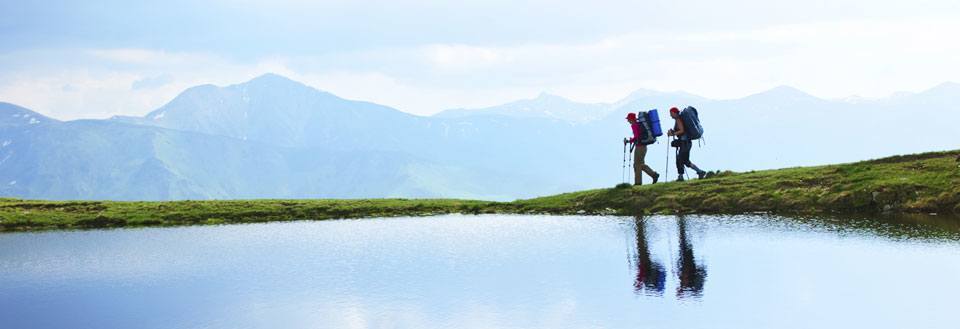Majestic castles and medieval towns surrounded by fortified walls and deep moats, these are all part of this rural and picturesque area. You have an excellent opportunitiy to hike in Romania's famous mountains - the Carpathians.�
Romania
Bucharest (2,500,000)
237,500 sq km
Romanian
Romanian Orthodox
23,000,000
Republic
Northeastern Romania borders with Moldova and Ukraine, and southeastern Romania borders the Black Sea and Bulgaria. In central-Romania is Transylvania, consisting of alpine mountains and large forests. The great mountain range, the Carpathians, stretches from north to south, and Romania is bounded by the Danube River next to Bulgaria.�
Romania can be visited all year around. The winter can be very cold with plenty of snow, which is rather good for the ski resorts. The best months to visit the country are in the summer between May and June, and also between September and October, when the beach areas are not as crowded. The rural areas can naturally be visited all year around.�
Lonely Planet Romania & Moldova
Romania; The Rough Guide
In spite of appearences the fact is that Romania is as far ahead, technologically, as the rest of Western Europe. So the possibilities of finding Internet connections are fairly good. Even in the beautiful medieval town of Sighisoara you can find an Internet café. There is of course an excellent chance of finding one in Bucharest, although you may have to look hard.�
In case of an emergency in Romania, call the following numbers:
Police (955)
Ambulance (961)
It isn't common practice to give tips in Romania; however, it is common to round up to the nearest 500 lei. Taxi drivers can be pretty tough, and you may need to bargain about the price.
When it is 12.00 in the UK it is 13.00 in Romania.�
In Romania, the following units of measurement are used:
Weight: kilogram.
Length: metre.
Volume: litre.
There are no particular rules concerning photographing, but you should of course ask first, when photographing the locals, as well as be aware of special rules in places of worship.
The tap water can be drunk in certain places, but it contains a lot of bacteria. It is recommended to buy bottled water to be on the safe side.
The following current is used in Romania:
220 volt,50 Hz.
The Romanians are a religious people, and when you visit places of worship, it is recommended to show a certain respect and formality towards the population. There is no particular dress code in churches, however.
Banks are open 9.00 to 12.00 and 13.00 to 15.00 (Monday to Friday).
Shops are open 9.00 to 12.00 and 14.00 to 20.00 (Monday to Friday).
Offices are open 7.00 to 15.30 (Monday to Friday).
Public offices are open 9.00 to 14.30 (Monday to Friday).
It is inexpensive to eat out in Romania, but it can be a bit difficult to find a restaurant or other place to eat. Most Romanians cannot afford to go out to eat, so there is no natural market for such places. You can go into the more expensive hotels where the dining-possibilities are better. The Romanians are well known for their local beer, and they have a long tradition of wine-making as well - of which some of the best are Cotnari and Murfatlar. Watch out for the coffee that the locals call Ness - it is nothing like any coffee you know from home.�
Romania isn't a well-equipped or hospitable country for disabled people. The services and facilities are close to zero, and it is recommended that disabled persons go on organised tours - or travel in groups.�
Public holidays:
New Year's Day, 1 January
The day after New Year's Day, 2 January
Ephiphany, 6 January
Labour Day, 1 May
National Day, 1 December
Christams Day, 25 December
Boxing Day, 26 December
Shifting holidays
Easter, March, April or May.
Camping is a common way of spending the night, also by the Romanians themselves. The camping sites often have small "bungalows", which are one-room cabins without many facilities. These are often used by the Romanian youth and can be a quite decent place to spend the night.
You won't find the same hotel standards as in Europe, but the staff is often polite and will help you find a place to stay if everything is booked. Hotels are categorised from one to four stars.
The mountains often have excellent opportunities for spending the night at a hostel or in a cabin, which are often cheaper than the city's hotels and private rooms.
There are domestic flights, but as foreigners often pay more than the locals it becomes too expensive to use.
The buses aren't as reliable and more crowded than the trains, and the timetables are often either invalid or incorrect. Private companies are beginning to appear and improving the conditions.
The train system is reliable and well developed in Romania, and you can even find some charming, old trains, which aren't as comfortable, but gain by their historical charm. As it is very cheap to travel in Romania, you might as well go first class. The national railroad company (CFR) covers more than 11,000 km of railroad.
Most taxis drive with a taxi-meter and can be hailed in the street or phoned for in the hotel. There are also private taxis with the sign "P" or "PO", but you have to bargain the price beforehand with them.�
It is easy to rent a car in Romania, but the prices are rather high.
There is regular boat-service on the Danube River and in the Danube Delta area.�
